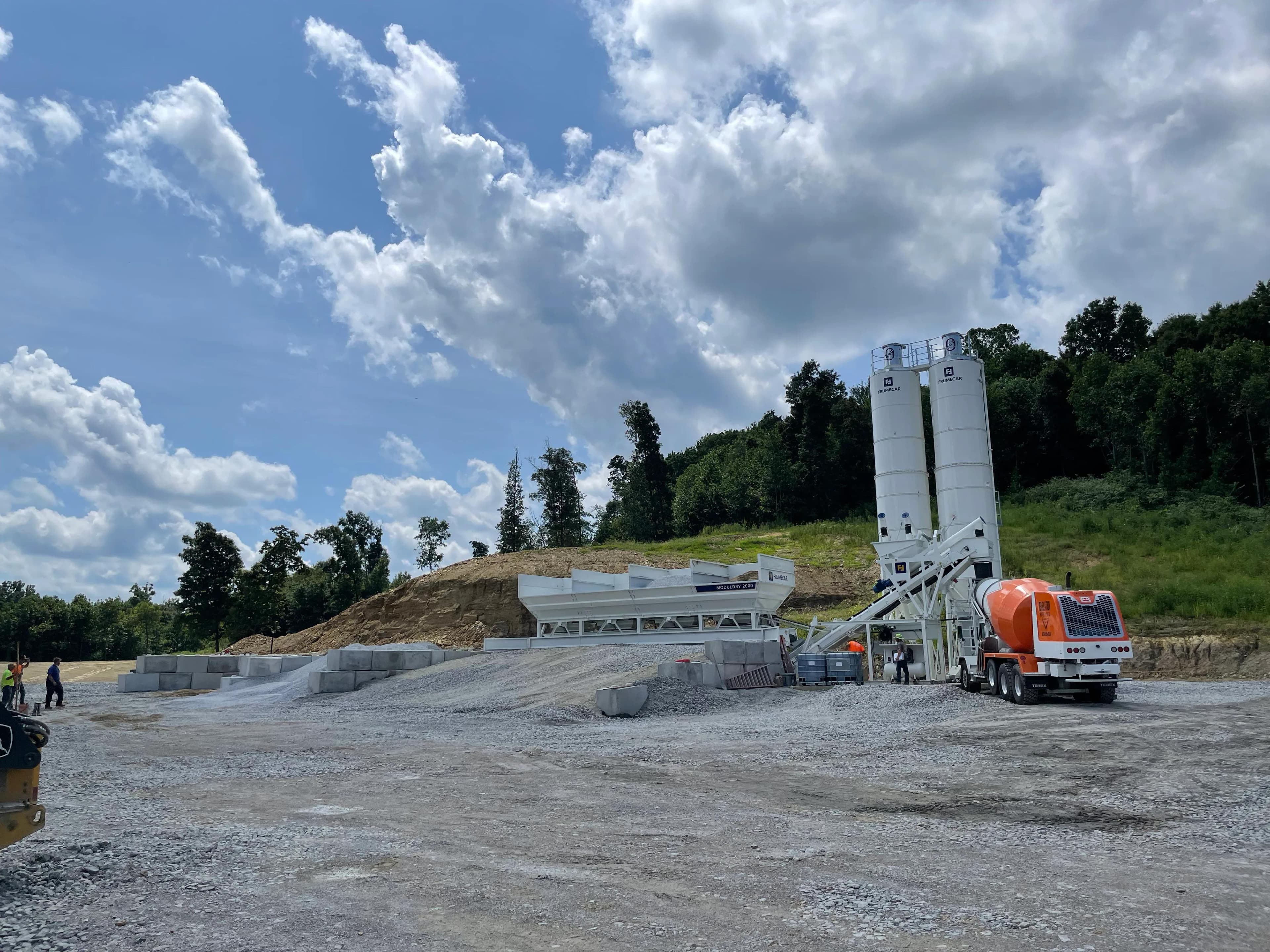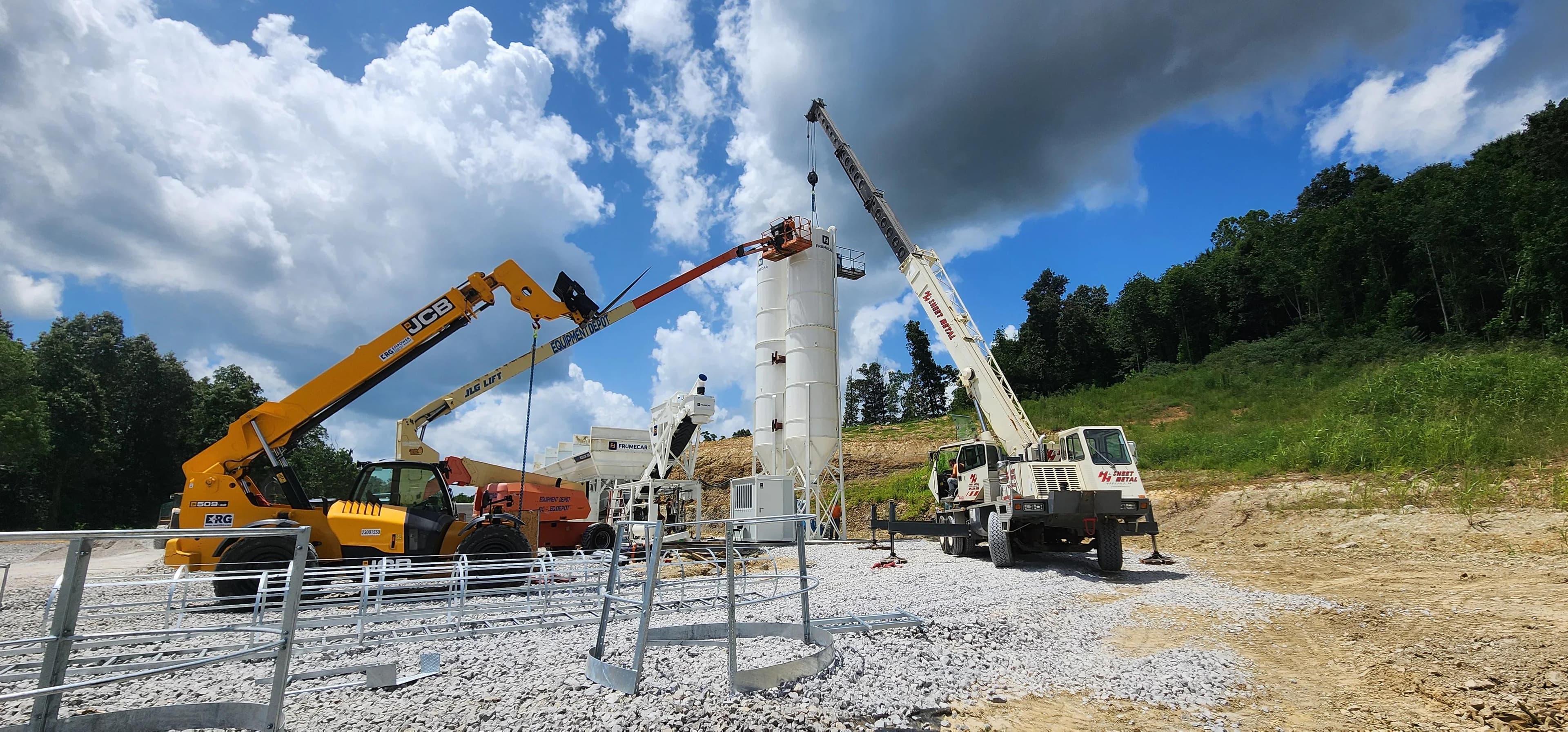Cement Silos: A Complete Guide for On-Site Concrete Production and Storage

Introduction
Concrete operations depend on consistency. Whether you run a ready-mix plant, a precast facility, or a mobile concrete batching operation, the biggest threat to productivity is running out of cement at the wrong time. Cement silos solve this problem by storing high volumes of powdered material safely and feeding batching systems with a stable, controlled supply.
Contractors today are shifting more production on-site to eliminate delays and reduce dependency on ready-mix deliveries. Portable cement silos allow crews to produce concrete where the work is happening, keeping schedules tight and pour cycles predictable. Compared to hauling bagged materials or relying on off-site plants, an on-site silo is more efficient, cost-effective, and reliable.
For ready-mix and precast producers, a well-designed silo also improves accuracy, lowers contamination risk, and reduces manual handling. When combined with batching plants, mixers, and screw conveyors, a silo becomes the heart of a clean, continuous, and high-capacity concrete production line.

What Cement Silos Do
A cement silo is a sealed storage vessel engineered to hold powdered materials such as cement, fly ash, lime, or GGBFS. It maintains these materials in a dry, flowable state and discharges them accurately into augers, screw conveyors, or batching systems.
Material flow inside the silo is supported by aeration pads, vibrators, and conical geometry. These systems prevent compacting, bridging, or hang-ups that can interrupt production. During filling, dust collectors and baghouses keep the environment clean and prevent over-pressurization. Level indicators allow plant operators to track capacity, ensure batching accuracy, and schedule refills without guesswork.
By acting as a controlled storage solution, the silo supports every downstream part of the concrete process—from mixer feed rates to batching precision to overall plant throughput.
Types of Cement Silos
Different projects require different storage solutions. Capacity, mobility, height restrictions, and production demands all influence which silo type is the right fit.
Mobile Cement Silos
Mobile cement silos are built for contractors who batch concrete directly at the job site. They are typically low-profile for easier transport, fast setup, and fewer permitting requirements. A mobile unit integrates easily with portable batching plants and on-site mixers, making it ideal for infrastructure projects, rural jobs, or any operation that moves frequently.

Stationary / High-Capacity Silos
Stationary silos are used in ready-mix plants, large precast facilities, and aggregate batching operations where high cement volume is essential. These silos offer the greatest capacity (often measured in cubic feet or barrels) and are engineered for long-term durability. They pair with large screw conveyors, blowers, and dust collectors to support continuous concrete production.
Low-Profile Silos
Low-profile designs are chosen for sites with height restrictions or where frequent relocation is required. With a lower center of gravity, these silos are easier to transport, safer to set up, and more practical for urban jobs or enclosed facilities.
Vertical Silos
Vertical silos take advantage of height to maximize storage capacity within a small ground footprint. They are common in concrete plants with steady production demands, where consistent discharge and large material reserves are essential.
Bolt-Together and Modular Silos
Bolt-together silos ship in compact panels and are assembled on-site. This makes them cost-effective to transport and ideal for growing ready-mix or precast operations that need additional storage without purchasing another fully welded unit. Modular components also simplify maintenance and upgrades.
Cement Silo Capacities
Silo capacity is typically expressed in cubic feet or barrels (bbl). Larger plants may use 1,000+ barrel silos, while mobile operations often rely on smaller low-profile units that balance portability with daily production requirements.
Capacity selection is based on:
- Daily concrete output
- Cement delivery schedule
- Batch size and mixer throughput
- Type of material stored (cement, fly ash, lime, blended powders)
Undersizing a silo results in stoppages during refills, while oversizing wastes capital and real estate. The right capacity supports consistent batching cycles without interruptions.
How Cement Moves Through a Silo
Inside every silo is a flow system engineered to keep powdered material moving without clumping or clogging.
Key flow mechanisms include:
- Vibrators to break up material that settles or compacts
- Aeration pads that inject air and keep cement fluidized
- Conical hoppers shaped to promote predictable discharge
- Screw conveyors or augers that move cement from the cone to the mixer
- Blow-in fill pipes that connect directly to cement delivery trucks
When designed correctly, the silo maintains reliable flow from initial loading to final discharge into the batching plant.
Key Components of a Cement Silo
A cement silo is more than a storage tank. It is a controlled, engineered system with several parts working together to ensure accurate discharge, smooth material flow, and safe operation. Below are the components buyers most commonly evaluate when selecting a silo for ready-mix, precast, or on-site production.
Auger / Screw Conveyor
The auger transports cement from the cone of the silo into the batching plant or mixer. Screw conveyors come in various diameters and lengths depending on target output, silo height, and plant layout. A well-sized auger prevents bottlenecks and supports high-capacity batching cycles.
Vibrator
Mounted on the lower portion of the silo, the vibrator assists material flow by preventing bridging or compaction. This is especially useful with cement stored for long periods, in humid environments, or when using blended powders.
Aeration Pads
Aeration systems inject controlled air into the material to keep it fluidized. Without aeration, cement can settle and compact, creating discharge issues that slow down batching.
Level Indicators
These sensors track fill levels inside the silo and notify operators when it is time to reorder. They help plants maintain batching accuracy, protect against unexpected outages, and prevent overfilling during delivery.
Dust Collector / Baghouse
Dust collectors capture fine particles during filling to maintain a clean environment and protect the silo from over-pressurization. This also ensures air leaves the silo at a controlled rate during cement delivery.
Fill Pipe
The fill pipe connects directly to the cement delivery truck’s blower system. It allows cement to be pneumatically conveyed into the silo while keeping the system sealed.
Air Compressor
The air compressor powers aeration pads, dust collection, and other airflow-driven components. Consistent air pressure is essential for keeping cement moving freely inside the silo.
Manhole
A built-in access port allows for inspection, cleanout, or maintenance. Manholes are critical in regions where cement can clump or where multiple materials are stored throughout the year.
Heavy-Duty Frame and Cone
The frame supports the silo and protects it from vibration and impact. The cone is precision shaped to ensure predictable material flow and consistent discharge into the auger.
Applications Across the Concrete and Construction Industry
Cement silos support nearly every concrete production workflow, from large commercial pours to remote infrastructure builds.
Ready-Mix Production
Ready-mix plants rely on large-capacity silos to ensure continuous batching cycles throughout the day. High-capacity silos paired with automated batching systems help maintain mix accuracy and consistent throughput.
On-Site Concrete Production
Portable and mobile cement silos allow contractors to produce concrete directly at the job site. This reduces reliance on ready-mix deliveries, avoids scheduling delays, and ensures crews can pour at any time.
Precast Manufacturing
Precast facilities depend on precise batching and high material availability. Multiple silos are often used to store different powdered materials, improving flexibility in mix design.
Infrastructure and Remote Projects
Projects such as bridges, tunnels, or utility work benefit from mobile silos that support batching plants in remote areas where ready-mix trucks cannot deliver consistently.
Large Commercial Builds
High-rise, industrial, or multi-phase construction projects often use on-site batching plants supported by silos to eliminate delays and increase production capacity.

Buying Considerations for Cement Silos
Choosing the right silo involves understanding material requirements, site conditions, and production goals.
Capacity Requirements
Capacity is measured in cubic feet or barrels. The goal is to size the silo so production is never interrupted by refills. Undersized silos cause downtime; oversized silos cost more and take extra space.
Portability vs. Permanence
Job sites that move frequently benefit from mobile or low-profile units. Established ready-mix or precast facilities generally select large stationary silos with integrated blowers and dust collectors.
Discharge Requirements
The size and speed of the auger determine how quickly cement reaches the mixer. Plants with high-throughput mixers need fast, continuous discharge.
Material Flow Technology
Aeration pads, vibrators, hopper design, and internal coatings all affect how easily cement moves. Blended cements or fly ash may require more robust flow systems.
Dust Control and Environment
Dust collectors, baghouses, and sealed fill systems are essential for clean operation. Municipal regulations may require specific dust control ratings.
Compatibility with Batching Plants
The silo must align physically and functionally with the batching plant, mixer, and screw conveyors already in use. Height, angle, and discharge position all matter.
Power and Air Requirements
Air compressors, blowers, and aeration systems require stable power and air supply. Remote sites need reliable generators or integrated storage systems.
Maintenance and Reliability
Cement silos require regular inspection to maintain flow, prevent contamination, and protect equipment.
- Inspect aeration pads and schedules regularly.
- Check screw conveyor bearings and drives for wear.
- Clean dust collectors or baghouse filters.
- Inspect level indicators for accuracy.
- Check seals around the fill pipe and manhole to ensure airtight operation.
- Monitor moisture exposure to prevent clogging or cement hardening inside the cone.
Preventative maintenance reduces downtime and protects the batching plant from unplanned outages, especially on high-output job sites.
Example Cement Silos Available Through Machinery Partner
Machinery Partner offers a curated selection of silos engineered for concrete production, batching plants, and mobile job sites.
Portable Cement Silos are designed for rapid deployment and high mobility. These mobile units integrate with portable concrete plants, allowing contractors to batch concrete directly where the work is happening.
Low-Profile Silos are ideal for transport in urban areas, sites with height restrictions, or operations requiring frequent relocation. Their design allows easy loading without permits for oversized loads.
High-Capacity Stationary Silos serve ready-mix plants, precast factories, and permanent concrete production installs. These silos are built with heavy-duty structural components, dust collectors, and high-volume screw conveyors.
To explore sizing, lead times, and financing options, get a quote on a cement silo.

Frequently Asked Questions About Cement Silos
What is a cement silo used for?
A cement silo stores powdered materials such as cement, fly ash, and lime in a dry, flowable, and sealed environment. It feeds batching plants and mixers with a consistent material supply.
What size silo do I need for concrete production?
It depends on daily throughput, batch volume, and refill frequency. Larger operations may use 1,000-barrel silos, while mobile job sites prefer low-profile portable units.
What is the difference between a mobile silo and a stationary silo?
Mobile silos are designed for transport and quick setup on the job site. Stationary silos are fixed installations for high-capacity ready-mix or precast production.
How does cement flow out of a silo?
Flow is managed by vibrators, aeration pads, silo cone geometry, and a screw conveyor that transports material to the mixer or batching plant.
What is a silo vibrator used for?
It prevents cement from bridging or compacting inside the cone, ensuring smooth and consistent discharge.
Do cement silos need an air compressor?
Yes. Air compressors run aeration pads, dust collectors, and other airflow systems that keep cement moving.
What is a dust collector on a cement silo?
A dust collector removes fine particles during filling to maintain a clean job site and prevent over-pressurization.
Can cement silos be used with portable concrete plants?
Yes. Portable and low-profile silos are specifically designed to integrate with mobile batching plants for on-site production.








